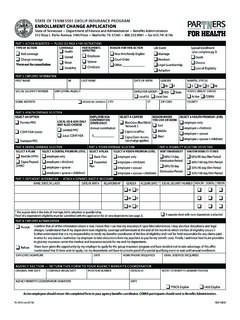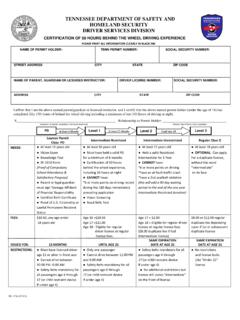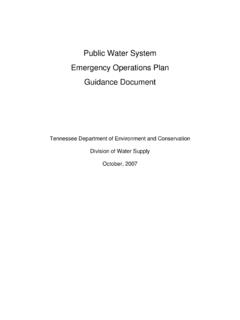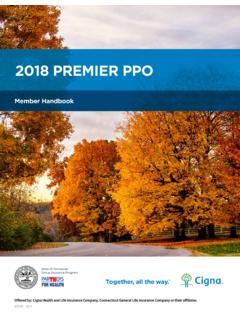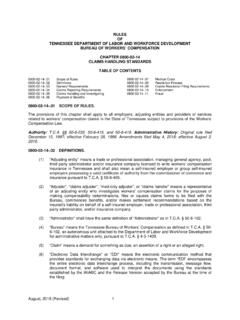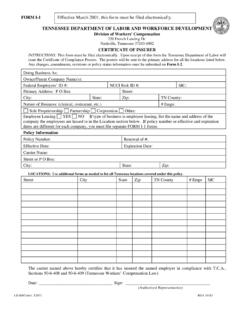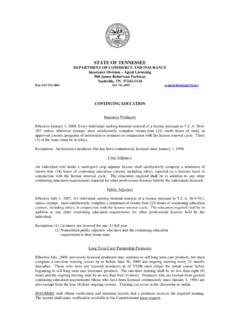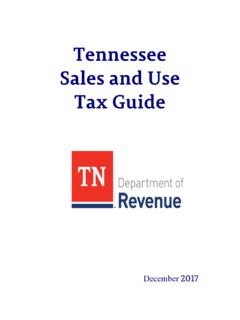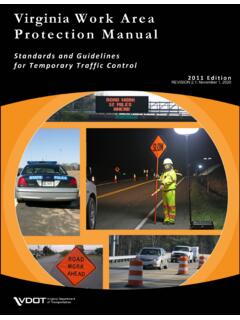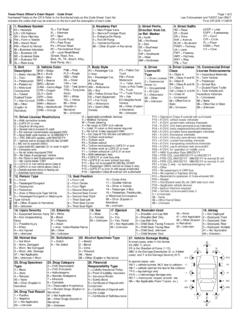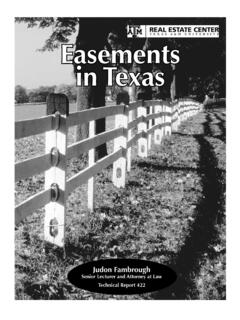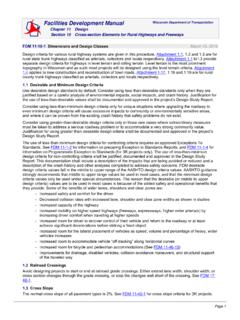Transcription of Manual for Constructing Driveway Entrances - Tennessee
1 Manual for Constructing Driveway Entrances on State Highways 2015 Edition Table of Contents | i Table of Contents Page SECTION 1 - INTRODUCTION Purpose 1-1 History 1-1 Need 1-1 Authority 1-1 Severability 1-2 Definitions 1-2 SECTION 2 - HIGHWAY ENTRANCE PERMIT General 2-1 Residential Driveways and Field Entrances 2-1 Coordination with Local Authorities 2-1 Liability Insurance 2-2 Bond Requirements 2-2 Requirements for Application 2-3 SECTION 3 - RIGHT-OF-WAY ENCROACHMENT General 3-1 Buffer Areas 3-1 Parking and Storage 3-1 SECTION 4 - ACCESS POINTS Types of Highway Access 4-1 Number of Entrances 4-2 SECTION 5 - ACCESS DESIGN Control Dimensions 5-1 Edge Clearance 5-1 Driveway Angle 5-1 Radius of Curvature 5-2 Entrance Width 5-2 Corner Clearance 5-3 Distance Between Double Driveways 5-3 Tennessee Department of Transportation 2015 Edition Table of Contents | ii Fuel Pump Clearance 5-3 Commercial Border area Clearance 5-3 Sight Distance 5-4 Driveway Construction and Grading Standards 5-5 Residential and Field Entrances on Roads Without Curb & Gutter 5-6 All Other Uses on Roads Without Curb & Gutter 5-6 Driveways on Roads With Curb & Gutter 5-6 Pavement Section 5-7 Signs and Pavement Markings 5-7 Median Openings and Spacing 5-7 Traffic Impact Studies 5-7 Auxiliary Lanes 5-8 Design of
2 Auxiliary Lanes: 5-8 Unsignalized Intersections: 5-9 Signalized Intersections: 5-9 Department s Design Standards and Guidelines 5-9 SECTION 6 - DRAINAGE General 6-1 Design of Drainage System 6-1 Construction 6-1 SECTION 7 - ENGINEERING EXCEPTIONS General 7-1 SECTION 8 - MAINTENANCE General 8-1 APPENDICES Appendix A - Example Drawings A-1 to 11 Tennessee Department of Transportation 2015 Edition Section 1 - Introduction | 1 1 1 Introduction Purpose The purpose of the Driveway permit process is to manage access on the State Highway System. Access regulations are necessary in order to preserve the functional integrity of the State Highway System and to promote the safe and efficient movement of people and goods while providing reasonable access to adjoining property owners.
3 Reasonable access means that a property owner will have access to the public highway system, but it does not mean that potential patrons are guaranteed the most direct or convenient access from a specific roadway to the owner s property. This Manual is intended to define the process for Constructing a legal Driveway or other work within the State Highway rights-of-way. History In 1974, the Tennessee Department of Highways, now known as the Tennessee Department of Transportation, adopted rules and regulations governing the construction of driveways on state highway right-of-way. Some of these rules were amended in 1978, but there have been no revisions since then . This new Manual represents a comprehensive overhaul of the Driveway regulations.
4 A summary of changes can be found on the TDOT Traffic Engineering Office website s Highway Entrance Permit page. Need Every access point constructed on the state highway system increases the crash risk. The cumulative impact of closely spaced access points over time is one of the largest contributors to high crash rates and congestion on state highways. The majority of states in the nation have updated their Driveway access standards in the last 20 years to curtail the accelerated degradation to highway efficiency and safety. It is the Department s intent to adopt national best practices that better preserve the safe and efficient movement of people and goods while also helping property owners make better decisions regarding access needs.
5 Outdated access policies not only fail to protect the interests of highway users but also fail to enhance the economic opportunities a highly efficient roadway network offers businesses and customers. Authority This Manual is authorized by the following sections of the Tennessee Code Annotated: (a) Section 4-3-2303(2), Powers and duties of commissioner, which authorizes the Commissioner to promulgate regulations governing the administration and operations of the Department. (b) Section 54-5-301(a), Regulations governing construction of Entrances Penalty for illegal Entrances , which authorizes the Commissioner to make reasonable and proper rules governing the construction of Driveway Entrances on the State Highway System. (c) Section 54-5-302, Agreement prior to construction mandatory, which provides that no person Tennessee Department of Transportation 2015 Edition Section 1 - Introduction | 1 2 may co nstruct any entrance onto a state highway unless it is constructed in accordance with the rules and regulations adopted by the Commissioner.
6 Severability If any provision of this Manual of standards and guidelines is proven or held to be invalid or unconstitutional, such invalidity shall not affect the validity of these standards and guidelines as a whole, or any part thereof, other than the part determined to be invalid. Definitions AASHTO The American Association of State Highway and Transportation Officials. Access Point A location on a property frontage at which access to a state highway is allowed by the Department. ADA or Americans with Disabilities Act of 1990 Federal law prohibiting discrimination against persons with disabilities. Requires public entities and public accommodations to provide accessible accommodations for persons with disabilities. Americans with Disabilities Act Accessibility Guidelines (ADAAG) Scoping and technical specifications for new construction and alterations undertaken by entities covered by the ADA.
7 Algebraic Difference in Grade The total change in grade between intersecting grades. Apron That portion of the Driveway extending from the edge of the pavement of the through roadway to the back of sidewalk section, or the right-of-way line if no sidewalk exists. Applicant The owner of a property or the owner s representative applying for a state highway entrance permit. Auxiliary Lane A lane along the roadway that is used for the purpose of acceleration, deceleration, or storage of vehicles for turning movements. Buffer area The border area along the frontage of a property, between the traveled way and the right-of-way line, and within the frontage boundary lines. Commercial Border area The border area along the frontage boundary line that extends outside the right-of-way line onto a tract of commercial property.
8 This area is designed to prevent vehicles from parking or being serviced on state owned right-of-way. Typically, commercial border areas are grassy or mulched, and surrounded by a concrete curb. Commercial Border area Clearance The distance, measured perpendicular to the right-of-way line, between the right-of-way line and the edge of the commercial border area . See Figure dimension CB . Tennessee Department of Transportation 2015 Edition Section 1 - Introduction | 1 3 Connection Any Driveway , street, turnout, or other means of providing for the movement of vehicles to or from the public roadway system. Corner Clearance At an intersecting street or highway, the distance measured along the edge of traveled way between the intersection of right-of-way lines and the tangent projection of the nearest edge of the Driveway .
9 See Figure dimension C . Crossover A paved or graded area of the highway median designed to allow vehicles to cross the median of a divided highway. Department The Tennessee Department of Transportation. Distance Between Double Driveways The distance measured parallel to the right-of-way line between the tangent edges of two adjacent driveways servicing the same frontage. In the case of driveways at an angle less than 90 to the traveled way, the minimum distance required between them shall be applied at the point where the two tangent edges are closest to the traveled way. See Figure dimension D . Driveway An improved area between a public road and private property used to provide ingress and egress of vehicular traffic from the public road to a definite area of private property.
10 Driveway Angle The angle of 90 or less between the Driveway centerline and the edge of the traveled way. See Figure dimension Y . Driveway Width The perpendicular distance between the parallel edges of a Driveway . See Figure dimension W . Drop/Lowered Curb A curb with reduced vertical dimension to allow vehicular access in specific areas while containing the flow of storm water under common flow conditions. Edge Clearance The distance measured parallel to the edge of the traveled way, between the frontage boundary line and tangent projection of the nearest edge of Driveway . In the case of driveways at an angle less than 90 to the traveled way, the edge clearance shall be measured between the frontage boundary line and the point where the tangent edge of the Driveway is closest to the traveled way.
